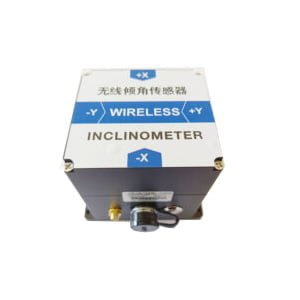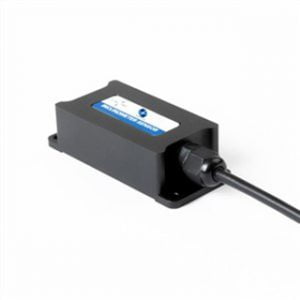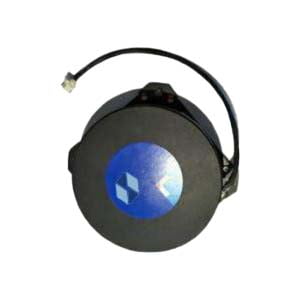Tilt Sensor also known as inclinometer, inclinometer, tilt sensor level and inclination meter, is often used in the measurement of horizontal angle change of the system. The level from the simple bubble level in the past to the present electronic level is the result of the development of automation and electronic measurement technology. As a detection tool, the inclination sensor has become an indispensable important measurement tool in the fields of bridge erection, railway laying, civil engineering, oil drilling, aviation and navigation, industrial automation, intelligent platform, mechanical processing and so on. The electronic level meter is a very accurate measuring tool for small angles. It can be used to measure the inclination of the measured plane relative to the horizontal position, the parallelism and perpendicularity of the two parts.
Inclination sensors can be used to measure the change in inclination relative to a horizontal plane. The theory is based on Newton’s second law, which states that, according to the basic laws of physics, inside a system, velocity cannot be measured, but acceleration can be measured. If the initial velocity is known, the linear velocity can be calculated by integration, and the linear displacement can then be calculated. So it’s really an acceleration sensor that uses the principle of inertia. When the tilt sensor is at rest, that is, there is no acceleration on the side or in the vertical direction, only the acceleration of gravity is acting on it. The angle between the vertical axis of gravity and the sensitive axis of the acceleration sensor is the inclination angle. A general sense of angle sensor is static or quasi-static measurement, once has the external acceleration, then the acceleration measured acceleration which outside acceleration, chip, so the angle of the calculation is not accurate, so, now commonly used way is to increase the mems gyroscope chip, and USES the priority of kalman filtering algorithm. Acceleration 3 axes, gyroscope 3 axes, all products here are also called 6 axis or VG (vertical gyro).
With the development of MEMS technology, inertial sensor components have become one of the most successful and widely used MEMS components in the past few years, and micro accelerometer is an outstanding representative of inertial sensor components. As the most mature inertial sensor applications, MEMS accelerometers now have a very high degree of integration, that is, the sensing system and interface lines are integrated on a chip. The tilt sensor integrates the MCU, MEMS accelerometer, analog-to-digital conversion circuit, and communication unit all on a very small circuit board. Can directly output angle and other oblique data, so that people more convenient to use it. Its characteristic is: silicon micromechanical sensor measurement (MEMS) with horizontal plane as the reference plane of 2 axis tilt change. The output angle is based on the level and the datum can be recalibrated. Data output, interface forms including RS232, RS485 and customizable and other ways.Strong ability to resist external electromagnetic interference.
Difference between single axis and 2 axis tilt sensor
The number of mounted axes of inclination sensors can be classified into single axis and 2 axis types. We often say that the inclination sensor generally refers to a single axis of the inclination sensor, and the single axis refers to the central axis around the instrument when measuring the angle, or a certain direction. The 2 axis inclination sensor is a measurement tool designed for the size of the angle between two directions on the basis of the single axis in combination with the specific practical requirements. Angle sensor can be installed in horizontal and vertical, according to the different installation way, single axis and 2 axis angle sensor measurement of angle is different also, 2 axis flip and pitching angle can be measured, and the single axis can only be measured when choosing horizontal angle and pitching angle, if single shaft when choosing vertical installation can only measure turn angle, pitching angle not optional. Dual-axis inclinometer has the measurement advantages of single axis inclinometer, and has the measurement effect that single axis inclinometer can’t achieve at the same time, and has a wider measurement range.
By directly measuring the acceleration of the measured object, the 2 axis inclination sensor can obtain the linear velocity of the object through integral operation, and then the displacement of the object can be obtained further. Fundamentally, the inclination sensor is still an inertial sensor, which follows the inertial law of object motion and integral calculation method. 2 axis sensors are designed based on this basic principle, in addition to other measuring principles and measuring methods. The 2 axis inclination sensor shares two sensitive axes, which are X axis and Y axis. When the sensitive axis is perpendicular to the direction of gravity, the output change value caused by each tilt of one degree is larger. When the sensitive axis is at an angle of 45 degrees to the direction of gravity, the change value caused by each time is small. When the two are nearly parallel, each offset hardly causes any change in the output. According to this principle, the 2 axis inclination sensor can measure more types of objects and measure more types of angles, greatly improving the measurement efficiency. The 2 axis inclination sensor can basically fulfill the measurement requirements of the single axis inclination sensor.
In addition, the 2 axis inclination sensor can measure the angle of an irregular-shaped object, which can be determined by the angle difference between the two directions. In addition, multiple measurements of the same object from different directions and angles and then the mean value can be measured to get a more accurate angle, which greatly improves the measurement accuracy. The second point is that the 2 axis tilt sensor can measure both the roll angle and the pitch angle of the object. When the X axis and Y axis are perpendicular to the direction of gravity, the two angles obtained at this time are respectively the roll angle and pitch angle of the measured object. Simultaneity of 2 axis inclination sensor can reduce the error caused by separate measurement, which is the key function of 2 axis inclination sensor. However, the accuracy of the 2 axis inclinometer is not as good as that of the single axis inclinometer, which needs to be improved.
Difference between tilt sensor and gyroscope
Gyroscope is an angular motion detection equipment that uses the moment of momentum of a high-speed rotating body to sensitive the shell relative to the inertial space around one or two axes orthogonal to the rotation axis. Gyroscope varieties are many, according to the use of points, it can be divided into sensing gyroscope and indicating gyroscope. Sensor gyroscope is used as a sensor of horizontal, straight, pitch, course and angular velocity in the automatic control system of flying body motion. Indicator gyroscope is mainly used for indication of flight condition, as the appearance of control and navigation. Gyroscopes are piezoelectric gyroscopes, micro-mechanical gyroscopes, fiber optic gyroscopes and laser gyroscopes, which are all electronic, and they can work with accelerometers, reluctance chips, GPS, to make inertial navigation control system.
More Technical Questions
1.The Difference between Tilt Sensor and Gyro Sensor
2.How to install the tilt sensor?
3.What are Tilt Switches and Tilt Sensors?
4.How to Use the Tilt Sensor and How to Install It?
5.Do you Know the Working Principle of Inclinometer ?
6.How to choose a MEMS accelerometer?
Products in Article







